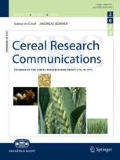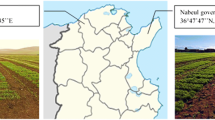Abstract
Tan spot, caused by the necrotrophic fungus Pyrenophora tritici-repentis, is an economically serious disease worldwide. However, little has been learned about the importance of this disease in Tunisia. This study was carried out to determine the distribution of tan spot in nine districts of Northern Tunisia and to assess its prevalence, incidence and severity according to the prospected districts and the most cultivated varieties. Surveys of 414 wheat fields were conducted in 2016, 2017 and 2018. Tan spot was detected in all prospected districts with a frequency of 37%, 64% and 89% in 2016, 2017 and 2018, respectively. Based on prevalence, incidence and severity data, the disease was especially important in Manouba and Zaghouan in 2016, in Bizerte, Ariana, Jendouba, Siliana and El Kef in 2017, and in all visited districts except for Siliana in 2018. It was more serious on durum than on bread wheat. The commercial durum wheat varieties ‘Maali’, ‘Karim’ and ‘Razzak’ were the most grown in Northern districts. ‘Maali’ was the most susceptible during the three years, while ‘Karim’ and ‘Razzak’ showed susceptible reaction only during two years; 2016 and 2017 for the first and 2017 and 2018 for the second. The recently introduced cultivars ‘Carioca’ and ‘Monastir’ and the bread wheat varieties ‘Utique’ and ‘Haidra’ were less susceptible than old improved durum wheat varieties. These findings are useful to farmers to choose most tolerant varieties in their growing area.





Similar content being viewed by others
References
Abdi Y (2015) Distribution spatiale des maladies fongiques du blé dur (Triticum durum Desf.) et effet de la fusariose sur le rendement en zones semi-arides de Sétif. Mémoire de Magister, Université Ferhat Abbas Sétif 1
Aboukhaddour R, Cloutier S, Lamari L, Strelkov SE (2011) Simple sequence repeats and diversity of globally distributed populations of Pyrenophora tritici-repentis. Can J Plant Pathol 33:389–399. https://doi.org/10.1080/07060661.2011.590821
Benbelkacem A, Bendif N (2010) Résultats des enquêtes, maladies et insectes des céréales en région Est de l’Algérie. Bilan PNAB Rev Céréaliculture 45:12–19
Bendif N (1994) La situation actuelle des maladies des céréales en Algérie. I.T.G.C. (Algérie). Rev Céréaliculture 27:9–12
Benslimane H, Bouznad Z, Aouali S, Khalfi A, Benbelkacem A, Sayoud R (2006) Prévalence de la tache bronzée du blé causée Pyrenophora tritici-repentis en Algérie. In: 6éme journées scientifiques et techniques phytosanitaires, Alger, Algeria
Benslimane H, Lamari L, Benbelkacem A, Sayoud R, Bouznad Z (2011) Distribution of races of Pyrenophora tritici-repentisin Algeria and identification of a new virulence type. Phytopathol Mediterr 50:203–211. https://doi.org/10.14601/Phytopathol_Mediterr-8746
Berraies S, Ammar K, Gharbi MS, Amor Y, Rezgui S (2014) Quantitative inheritance of resistance to Septoria tritici blotch in durum wheat in Tunisia. Chil J Agric Res 74:35–40. https://doi.org/10.4067/S0718-58392014000100006
Bhatta MR, Pokhare DR, Devkota RN, Dubin HJ, Mudwar A, Bimb HP, Thapa BR, Sah BP, Bhandari D (1997) Breeding for resistance to Helminthosporium Blights in Nepal: strategies and genetic gains. In: Duveiller E, Dubin HJ, Reeves J, Mc Nab A (eds) Heminthosporium blights of wheat: spot blotch and tan spot. CIMMYT, Mexico, pp 188–195
Bockus WW, Bowden R, Hunger R, Murray T, Smiley R (2010) Compendium of wheat diseases and pests, vol 3. APS Press, Chicago
Carmona M, Ferrazini M, Barreto DE (2006) Tan spot of wheat caused by Drechslera tritici repentis: detection transmission and control in wheat seed. Cereal Res Commun 34:1043–1049
Cherif M, Harrabi M, Morjane H (1994) Distribution and importance of wheat and barley diseases in Tunisia, 1989 to 1991. Rachis 13:25–34
Ciuffetti LM, Manning VA, Pandelova I, Betts MF, Martinez JP (2010) Host-selective toxins, Ptr ToxA and Ptr ToxB, as necrotrophic effectors in the Pyrenophora tritici-repentis—wheat interaction. New Phytol 187:911–919
Ciuffetti LM, Manning VA, Pandelova I, Faris JD, Friesen TL, Strelkov SE, Weber GL, Goodwin SB, Wolpert TJ, Figueroa M (2014) Pyrenophora tritici-repentis: a plant pathogenic fungus with global impact. In: Dean RA, Lichens-Park A, Kole C (eds) Genomics of plant-associated fungi monocot pathogens. Springer, Berlin, pp 1–39
Da Luz WC, Bergstrom GC (1986) Effect of temperature on tan spot development in spring wheat cultivars differing in resistance. Can J Plant Pathol 8:451–454. https://doi.org/10.1080/07060668609501786
De Wolf ED, Effertz RJ, Ali S, Francl LJ (1998) Vistas of tan spot research. Can J Plant Pathol 20:349–370. https://doi.org/10.1080/07060669809500404
ElFahem E (2017) Etude de la résistance de la collection nationale de blé à la maladie de la tache bronzée. Projet de fin d’études, Institut National Agronomique de Tunisie
Faris JD, Liu Z, Xu SS (2013) Genetics of tan spot resistance in wheat. Theor Appl Genet 126:2197–2217. https://doi.org/10.1007/s00122-013-2157-y
Gharbi MS, Berraies S, Ammar K, Yahyaoui A (2011) Delivering disease resistant cultivars to enhance sustainability of durum wheat production in Tunisia. In: Duveiller E, Singh PK et al (eds) 8th international symposium on mycosphaerella and stagonospora diseases of cereals. Book of abstracts. CIMMYT, Mexico, p 60
Hosford RM Jr (1972) Propagules of Pyrenophora trichostoma. Phytopathology 62:627–627. https://doi.org/10.1094/Phyto-62-627
Hýsek J, Vavera R, Růžek P (2017) Influence of temperature, precipitation, and cultivar characteristics on changes in the spectrum of pathogenic fungi in winter wheat. Int J Biometeorol 61:967–975. https://doi.org/10.1007/s00484-016-1276-y
Kamel AH, Harrabi M, Deghaies M, Halila H, Ben Salah M (1987) Wheat and barley diseases in Tunisia. Rachis 6:24–29
Kamel S, Cherif M, Hafez M, Despins T, Aboukhaddour R (2019) Pyrenophora tritici–repentis in Tunisia: race structure and effector genes. Front Plant Sci 10:1562. https://doi.org/10.3389/fpls.2019.01562
Kohli M, Mehta Y, Ackermann M (1992) Spread of tan spot in the Southern Cone region of South America. In: Francl L, Krupinsky J, Mc Mullen M (eds) Advances in tan spot. Proceedings of the Second International Tan Spot Workshop North Dakota State University. Fargo, ND, pp 86–90
Lamari L, Bernier CC (1989) Evaluation of wheat lines and cultivars to tan spot (Pyrenophora tritici-repentis) based on type lesions. Can J Plant Pathol 11:49–56. https://doi.org/10.1080/07060668909501146
Lamari L, Bernier C, Ballance GM (1992) The necrosis-chlorosis model in tan spot of wheat. In: Francl LJ, Krupinsky JM, McMullen MP (eds) Advances in Tan Spot Research: Proceedings of the 2nd International Tan Spot Workshop. Fargo, ND, USA: North Dakota Agricultural Experimental Station, p 13
Lamari L, Sayoud R, Boulif M, Bernier CC (1995) Identification of a new race in Pyrenophora tritici-repentis: Implications for the current pathotype classification system. Can J Plant Pathol 17:312–318. https://doi.org/10.1080/07060669509500668
Lamari L, Strelkov SE (2010) The wheat / Pyrenophora tritici-repentis interaction: progress towards an understanding of tan spot disease. Can J Plant Pathol 32:4–10. https://doi.org/10.1080/07060661003594117
Lamari L, Strelkov SE, Yahyaoui A, Orabi J, Smith RB (2003) The identification of two new races of Pyrenophora tritici-repentis from the host centre of diversity confirms a one-to-one relationship in tan spot of wheat. Phytopathology 93:391–396. https://doi.org/10.1094/PHYTO.2003.93.4.391
Laribi M, Gamba FM, Hassine M, Singh PK, Yahyaoui A, Sassi K (2019) Race structure and distribution of Pyrenophora tritici-repentis in Tunisia. Phytopathol Mediterr 58:473–483. https://doi.org/10.14601/Phyto-10892
Mansouri S, Radhouane L (2015) Dynamique du climat et impact sur la production d’orge dans la zone de Béjà au Nord Ouest de la Tunisie. Eur Sci J 11:85–103
Nasraoui B (2008) Main fungal diseases of cereals and legumes in Tunisia. Centre de Publication Universitaire, Tunisie
National Institute of Meteorology (2019) Public data, weather observation in Tunisia. Tunis, Tunisia
Nsarellah N, Boulif N (1997) Evaluation of tan spot research in Morocco. In: Duveiller E, Dubin HJ, Reeves J, Mc Nab A (eds) Heminthosporium blights of wheat: spot blotch and tan spot. CIMMYT, Mexico, pp 349–353
Nsarellah N, Mergoum M (1994) Comparison of Tan Spot virulence in the favorable and unfavorable rainfed areas of Morocco. MIAC—CRRA Settat (Ed) MARA- INRA, Rabat, pp 454–459
Nsarellah N, Mergoum M (1997) Effect of crop rotation and straw mulch inoculation on tan spot and root rot in bread and durum wheat. In: Duveiller E, Dubin HJ, Reeves J, Mc Nab A (eds) Heminthosporium blights of wheat: spot blotch and tan spot. CIMMYT, Mexico, pp 157–161
ONAGRI (2019) Estimation de la production nationale des céréales en 2019. Observatoire National de l'Agriculture. http://www.onagri.tn/uploads/images/prix/estimation-cereales-2019/Estimation-production-nationale-cereales-2019.pdf. Accessed 3 September 2020
Postnikova EN, Khasanov BA (1997) Tan spot in Central Asia. In: Duveiller E, Dubin HJ, Reeves J, Mc Nab A (eds) Heminthosporium blights of wheat: spot blotch and tan spot. CIMMYT, Mexico, pp 107–113
Ramdani A, Ibriz H (2000) Survey of wheat diseases in Morocco during three consecutive seasons 1997, 1998 and 1999. In: Royo C, Nachit M, Di Fonzo N, Araus JL (eds) Durum wheat improvement in the Mediterranean region: New challenges. Zaragoza, CIHEAM, pp 407–411
Sebei A, Ferjaoui S, Bchini H (2018) Yellow rust effects on grain yield, and yield components of some spring bread wheat cultivars under rainfed conditions. World J Agric Res 6:65–69. https://doi.org/10.12691/wjar-6-2-5
Tissaoui S, Kamel S, Mougou-Hamdane A, Cherif M, Nasraoui B (2016) Reaction of five durum wheat Tunisian varieties toward some populations of Pyrenophora tritici-repentis collected from different geographical origins. Tunis J Plant Prot 11:239–243
USDA (2019) Tunisia Grain and Feed Annual Bumper Crop within Reach. Global Agricultural Information Network. https://apps.fas.usda.gov/newgainapi/api/report/downloadreportbyfilename?filename=Grain%20and%20Feed%20Annual_Tunis_Tunisia_3-28-2019.pdf. Accessed 8 September 2020
Van Ginkel M, Rajaram S (1993) Breeding for durable resistance to diseases in wheat: an international perspective. In: Jacobs T, Parlevliet JE (eds) Durability of disease resistance. Kluwer Academic Publishers, Dordrecht, Netherlands, pp 259–272
Zadoks JC, Chang TT, Konzak CF (1974) A decimal code for the growth stages of cereals. Weed Res 14:415–421. https://doi.org/10.1111/j.1365-3180.1974.tb01084.x
Zahri S, Farih A, Badoc A, Douira A (2014) Statut des principales maladies, cryptogamiques foliaires du blé au Maroc en 2013. J Appl Biosci 77:6543–6549. https://doi.org/10.4314/jab.v77i1.5
Acknowledgements
We are thankful to the Regional Commissary for Agricultural Development for their help in planning the field surveys with farmers.
Funding
The research was supported by the federated project untitled “Identification of durum wheat resistant genotypes to biotic and drought stress and their valorization for sustainable agriculture” (RESIDUR), supported by the Institution of Agricultural Research and Higher Education (IRESA) under the Tunisian Ministry of Agriculture.
Author information
Authors and Affiliations
Contributions
S.K and M.C conceived the work. S.K performed the work and drafted the manuscript. M.C revised and edited the manuscript.
Corresponding author
Ethics declarations
Conflict of interest
The authors declare no conflict of interest.
Rights and permissions
About this article
Cite this article
Kamel, S., Cherif, M. Tan spot of wheat in Northern Tunisia: distribution, prevalence, incidence and severity. CEREAL RESEARCH COMMUNICATIONS 49, 421–432 (2021). https://doi.org/10.1007/s42976-020-00120-2
Received:
Accepted:
Published:
Issue Date:
DOI: https://doi.org/10.1007/s42976-020-00120-2




